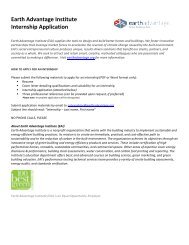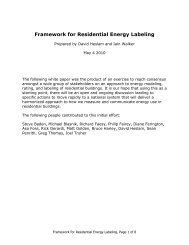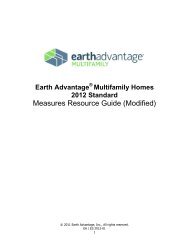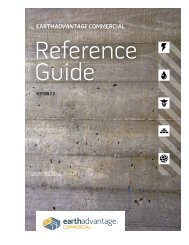EA New Homes Measures Guide - Earth Advantage
EA New Homes Measures Guide - Earth Advantage
EA New Homes Measures Guide - Earth Advantage
You also want an ePaper? Increase the reach of your titles
YUMPU automatically turns print PDFs into web optimized ePapers that Google loves.
2012 <strong>Earth</strong> <strong>Advantage</strong> Residential<br />
<strong>Measures</strong> Resource <strong>Guide</strong><br />
4.2 High Efficiency Equipment<br />
4.2.1<br />
Energy Health<br />
Forced Air Gas: Minumum 92% AFUE furnace<br />
Land Materials<br />
Prerequisite<br />
Description: Install a forced-air gas furnace with an Annual Fuel Utilization Efficiency (AFUE) rating of 92 percent or better.<br />
Water<br />
Benefit: Typical gas furnaces are rated at 80 percent efficiency. Installing a unit that has higher energy efficiency improves the HVAC<br />
performance and lowers operational costs. These high-efficiency models also have sealed combustion, so they draw combustion air from<br />
outside and are less vulnerable to back-drafting of combustion gasses.<br />
Verification: <strong>EA</strong> Rater will record the model number of the furnace and note the efficiency, if it is shown on the unit. The model number can<br />
be used to find equipment efficiency in the Gas Appliance Manufacturers Association directory.<br />
4.2.2<br />
Energy Health Land Materials Water<br />
Heat Pump: central system min. HSPF 8.5 (9.0 east of Cascades) with<br />
Prerequisite<br />
SEER 13+<br />
Description: Install a high-efficiency heat pump. When a heat pump is installed, back up heat may be provided by an 80 AFUE gas furnace.<br />
However, it is suggested that a 92 AFUE (or greater) is used.<br />
Benefit: Space heating and cooling can account for as much as 50 percent of the total energy usage of the home. Installing a high<br />
efficiency heat pump improves the energy efficiency and comfort of the house. With a heat pump installation, less carbon pollution is<br />
released into the air from the home heating system, causing less atmospheric deterioration. Compared to an electric resistance furnace,<br />
an air-source heat pump can deliver two to three times as much heat for each unit of electricity consumed.<br />
Verification: <strong>EA</strong> Rater will record the model number and serial number of the outdoor unit. HVAC contractor will supply the heat pump<br />
commissioning report from either CheckMe! or PTCS. HVAC contractors must be trained and certified by the appropriate regional authority<br />
to conduct the commissioning procedure.<br />
4.2.3<br />
Ductless Heat Pump System: Min. HSPF 8.5<br />
Energy<br />
Health<br />
Land Materials<br />
Prerequisite<br />
Description: Install a ductless heat pump. To qualify for this measure, the heat pump must use "inverter" technology, which makes the<br />
system capable of variable speed operation. Minimum efficiency is 8.5 HSPF. Despite their name, some of the indoor units are designed<br />
for short duct runs that allow a single unit to serve more than one room. These units and all associated ducts, must be installed in the<br />
conditioned space.<br />
Water<br />
Benefit: Ductless heat pumps (also called mini-splits) use refrigerant to distribute heating and cooling to the building without the use of air<br />
handlers and ductwork. They are well-suited to smaller homes, multi-family and townhome dwellings that do not have space available for<br />
HVAC ducts. They are also appropriate for smaller homes with smaller heating and cooling loads. In larger homes, multiple units can<br />
provide zoning capability. Because they do not require ducts, they don't suffer from duct losses. Most ductless heat pumps use ozonefriendly<br />
refrigerants, such as R-410A. Ductless heat pumps offer a method for adding cooling to homes with radiant floor heat.<br />
Verification: <strong>EA</strong> Rater will record the model number and serial number of the outdoor unit. HVAC contractor will supply documentation that<br />
the refrigerant charge meets manufacturer's specifications.<br />
Page 31 of 70








